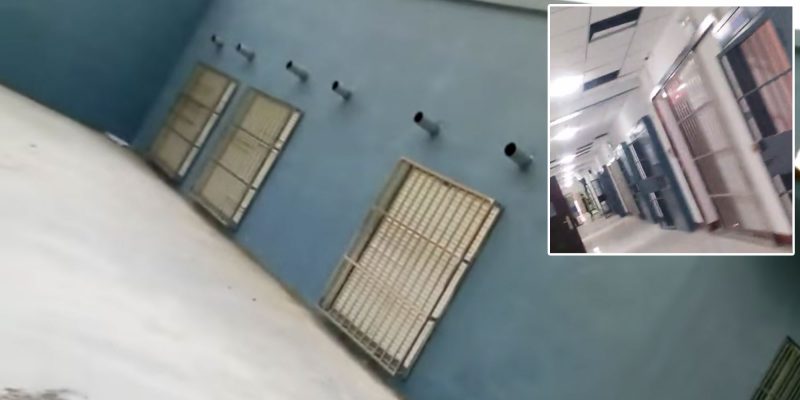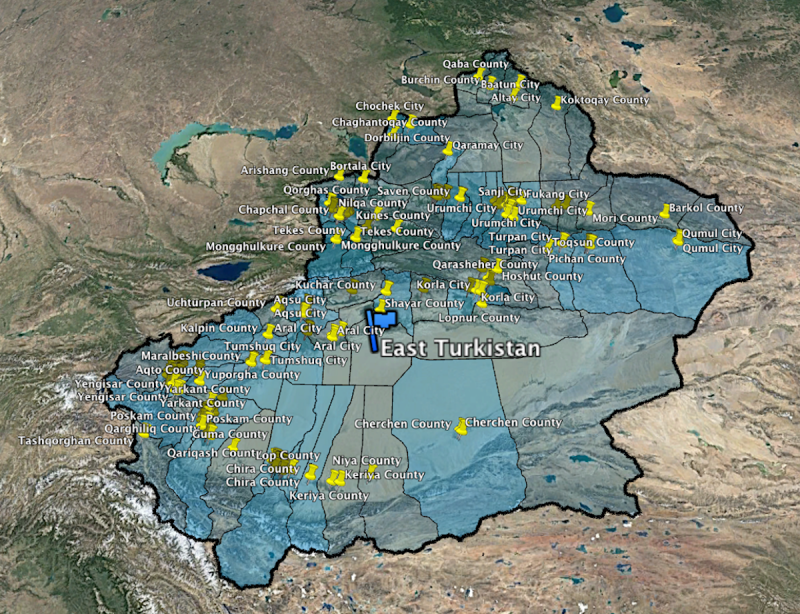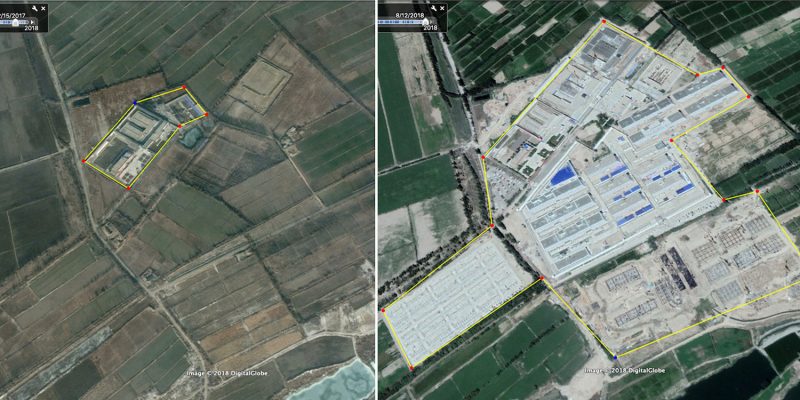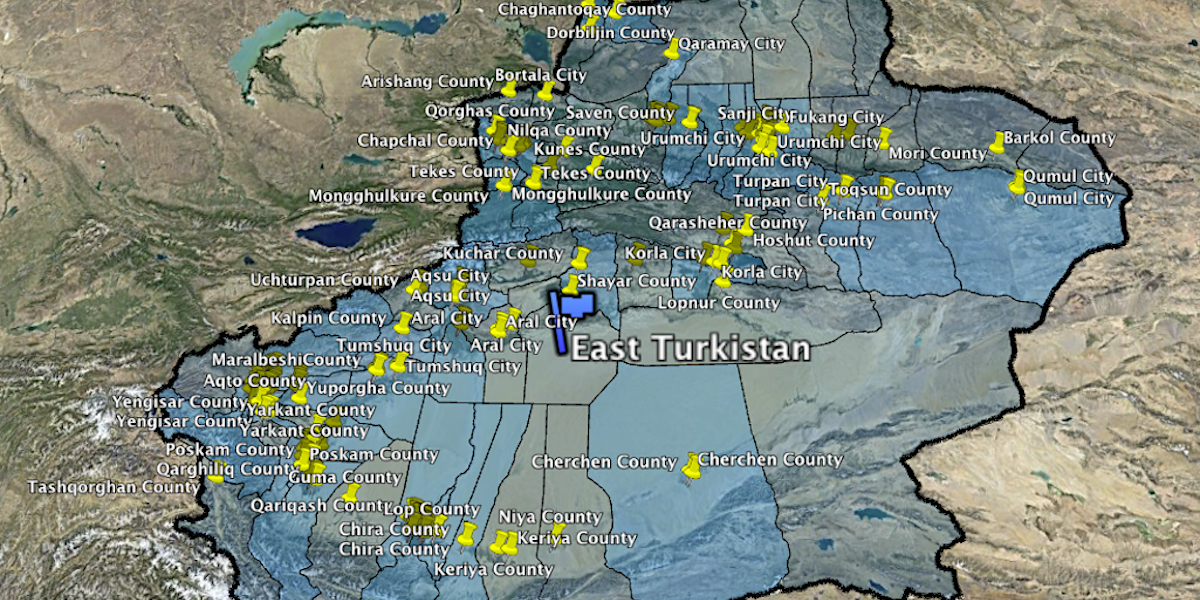- China is waging a massive security crackdown on the Uighur Muslim ethnic minority in detention camps and prisons in Xinjiang, western China. Many Uighurs call the region East Turkestan or East Turkistan.
- The US State Department estimated earlier this year that up to three million Uighurs might be imprisoned.
- Former detainees have spoken of torture and medical experiments in camps and prisons. China insists they are “free vocational training” or “re-education” camps.
- Researchers with the East Turkistan National Awakening Movement (ETNAM) activist group this week released maps showing the locations of 465 suspected prisons and detention camps in the region.
- About 40% of these sites had not been previously reported, suggesting that China might be detaining more than 3 million people, ETNAM’s president told Business Insider.
- Visit Business Insider’s homepage for more stories.
Activists have released a map showing the suspected locations of nearly 500 prisons and camps that China is using to lock up the Uighurs, a mostly-Muslim ethnic minority in the country’s western Xinjiang region.
Researchers working with the East Turkistan National Awakening Movement (ETNAM) on Tuesday released a series of maps showing suspected labor camps, “re-education” camps, and prisons in Xinjiang.
Xinjiang is the Chinese name for the 656,000-square-mile territory. Many Uighurs in the region and beyond refer to the vast territory as East Turkestan (or Turkistan) to protest China’s actions in the region.
China has been waging an unprecedented, hi-tech security crackdown on the region since mid-2016, justifying the actions as being in the name of counterterrorism. Uighurs and Han Chinese – the dominant ethnic group in China – have engaged in violent clashes in the past, and many Uighurs around the world want independence for the Xinjiang region.
The crackdown includes installing spyware on Uighurs' phones, forbidding them from communicating with people outside the region, and locking up at least 1 million people in detention camps and jails across the region.
Authorities reportedly send men to sleep with Uighur women whose husbands had been locked up.

China has tried to prevent journalists from reporting on what goes on inside those camps. It has formally acknowledged the existence of some of these camps, but euphemistically calls them "re-education camps," or says they offer "free vocational training."
Randall Schriver, the Assistant Secretary of Defense of Asian affairs, estimated this May that "at least a million but likely closer to three million citizens, out of a population of about 10 million" were detained.
Some of these camps are also reported to use forced labor to produce clothing, which ends up being sold by retailers in the West. Many retailers including the American Badger Sport, and Australia's Cotton On and Target Australia, have since cut ties with those suppliers.
ETNAM on Tuesday published a series of maps showing the coordinates of 182 suspected camps, which it calls "concentration camps."
You can see the locations in the map below:

About 40% of these sites had not been previously reported, Anders Corr, a former US intelligence analyst and current adviser to ETNAM, told Agence France-Presse.
The map below shows the locations of 182 suspected detention centers ("concentration camps"), 209 suspected prisons, and 74 suspected labor camps:

Researchers produced the coordinates of the suspected camps and prisons after a year of research. That research drew on information from Uighurs in the region who reported that their families had been detained, as well as on existing satellite imagery from other researchers on the region, Salih Hudayar, ETNAM's founder and president, told Business Insider.
He added that because so many of those facilities had not yet been identified, they "may represent an incarcerated population that may vastly exceed previous estimates of one to three million people detained," referring to Schriver's estimates.
Kyle Olbert, ETNAM's director of operations, added: "If anything, we are concerned that there may be more facilities that we have not been able to identify," according to Agence France-Presse.
At the time of publication, the Chinese embassies in Washington, DC, and London had not responded to Business Insider's request for comment on the suspected locations, and broader allegations about the situation in the Xinjiang region.

It's not clear from ETNAM's report how full the prisons are. However, according to The New York Times, incarceration rates in Xinjiang have sharply increased since 2016, with arrests often based on flimsy charges.
Radio Free Asia also reported last year that authorities were secretly transferring Uighur prisoners to jails around the country because the region's detention facilities had become too full.
Earlier this year, China claimed that it had released many Uighurs from re-education camps, but has not given enough specifics or evidence to back up the claim.
China has repeatedly refuted reports detailing human-rights abuses in the region, claiming instead that Uighurs live freely and are happy in their so-called vocational training camps.
According to former detention camp and prison detainees, people are shackled to chairs, subjected to medical experiments, and forced to sing propaganda songs to get food.
- Read more:
- Muslims in China's most oppressed, closed-off region are turning to China's version of Gen Z favorite TikTok to communicate with the world
- China is reportedly sending men to sleep in the same beds as Uighur Muslim women while their husbands are in prison camps
- This map shows a trillion-dollar reason why China is oppressing more than a million Muslims
- The last major opponent of China's Muslim oppression has retreated into silence. Here's why that's a big deal.


